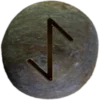Last Updated on January 17, 2025
Table of Contents



The Valknut (pronounced VAL-knoot) is one of the most recognizable symbols from Norse culture. Its name combines valr (slain warriors) and knut (knot), translating to “knot of the slain.” Other names include Hrungnir’s Heart or The Warrior’s Knot. The symbol consists of three interlocking triangles, often linked to death, warriors, and the afterlife.
The Valknut frequently appears on ancient artifacts, especially runestones and burial sites, often alongside depictions of Odin (pronounced OH-din). Odin’s role as a psychopomp—one who guides souls to the afterlife—connects the Valknut to death and transition. It is also seen on the Stora Hammars stones and other Viking-age artifacts, reinforcing its ties to sacrifice, courage, and fate.
Many scholars believe the Valknut symbolizes the bond between life, death, and the divine. It may also reflect the Viking view of destiny, as they believed their fates were controlled by the Norns (pronounced NORNZ), three mystical beings who wove the threads of life.
In Norse culture, symbols carried profound spiritual significance, and the Valknut stands as an emblem of bravery and loyalty. Its triangular design may represent unity or the tripartite nature of existence—birth, life, and death. While the exact meaning remains a subject of debate, its consistent association with warriors and sacrifice underscores its enduring power.
Today, the Valknut serves as a reminder of the courage and loyalty valued by the Norse. Its interwoven design continues to inspire admiration, preserving its historical and spiritual essence for modern generations.
Elder Futhark Runes Linked to the Valknut
The runes Eihwaz (ᛇ) and Tiwaz (ᛏ) resonate deeply with the Valknut’s themes. ![]()
Eihwaz (pronounced AY-wahz) symbolizes endurance, transformation, and a connection to the afterlife. Like the Valknut, it reflects the Norse understanding of life as a journey between worlds. This rune also represents the yew tree, often linked to resilience and the cyclical nature of existence.
Tiwaz (pronounced TEE-wahz) signifies honor, justice, and sacrifice. It embodies the warrior spirit and the willingness to endure hardships for a greater cause. The rune’s association with Týr, the god of justice and bravery, aligns with the Valknut’s focus on courage and loyalty in battle.
These runes together express the Valknut’s themes of perseverance, honor, and the inevitable transition from life to the afterlife.
The Valknut’s Importance to Asatruar
For Asatruar, the Valknut holds immense spiritual and cultural significance. It represents Odin’s guidance, the cycle of life and death, and the values of courage and loyalty.
In rituals, Asatruar often use the Valknut to honor fallen ancestors and warriors. It serves as a reminder to live with integrity, face challenges with bravery, and accept the natural cycles of existence. Many incorporate the symbol into their personal practices, carvings, or altars to strengthen their connection to Odin and the divine.
The Valknut also inspires meditation on fate and personal sacrifice. By reflecting on its interwoven design, Asatruar explore the interconnectedness of all things, including their ties to ancestors, the gods, and nature. Celebrating the Valknut bridges ancient traditions with modern spirituality, ensuring its powerful legacy endures.


